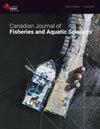Lake characteristics drive concordant trophic responses across ecosystems in three top predator fish species
IF 2.2
2区 农林科学
Q2 FISHERIES
Canadian Journal of Fisheries and Aquatic Sciences
Pub Date : 2023-12-04
DOI:10.1139/cjfas-2023-0240
引用次数: 0
Abstract
Understanding similarities in trophic ecology of top predators is crucial given their influences on food webs. We sampled walleye (Sander vitreus), northern pike (Esox lucius), and muskellunge (Esox masquinongy) from 17 Minnesota (USA) lakes and used δ13C and δ15N to estimate littoral carbon use, trophic position, and isotopic niche size of each species. All three species showed large inter-lake variability yet had concordant trophic responses across lakes, as littoral carbon use, trophic position, variability in littoral carbon and trophic position, and niche size were all positively related among species across lakes. Concordant responses were driven by a few key lake variables, with trophic position positively related to proportion littoral area and depth of hypoxic water, littoral carbon positively related to depth of hypoxic water and presence of zebra mussels (Dreissena polymorpha), and niche size inversely related to lake area. Our results indicate lake characteristics may influence food webs via consistent effects on multiple top predators. They also show that the amount of suitable habitat can be important for the ecosystem size hypothesis for trophic position.湖泊特征驱动三种顶级掠食性鱼类在不同生态系统中做出一致的营养反应
考虑到它们对食物网的影响,了解顶级捕食者营养生态的相似性是至关重要的。我们从美国明尼苏达州的17个湖泊中采集了白眼鱼(Sander vitreus)、梭子鱼(Esox lucius)和muskellunge (Esox masquinongy),并利用δ13C和δ15N估算了各物种的沿海碳利用、营养位置和同位素生态位大小。3种物种均表现出较大的湖间变异性,但在湖泊间具有一致的营养响应,湖泊间物种间的滨水碳利用、营养位置、滨水碳和营养位置变异性以及生态位大小均呈正相关。生态位大小与湖泊面积呈负相关,生态位大小与湖泊面积呈负相关,生态位大小与湖泊面积呈负相关,生态位大小与湖泊面积呈负相关。我们的研究结果表明,湖泊特征可能通过对多种顶级捕食者的一致影响来影响食物网。他们还表明,适宜栖息地的数量对生态系统大小假设的营养地位很重要。
本文章由计算机程序翻译,如有差异,请以英文原文为准。
求助全文
约1分钟内获得全文
求助全文
来源期刊

Canadian Journal of Fisheries and Aquatic Sciences
农林科学-海洋与淡水生物学
CiteScore
4.60
自引率
12.50%
发文量
148
审稿时长
6-16 weeks
期刊介绍:
The Canadian Journal of Fisheries and Aquatic Sciences is the primary publishing vehicle for the multidisciplinary field of aquatic sciences. It publishes perspectives (syntheses, critiques, and re-evaluations), discussions (comments and replies), articles, and rapid communications, relating to current research on -omics, cells, organisms, populations, ecosystems, or processes that affect aquatic systems. The journal seeks to amplify, modify, question, or redirect accumulated knowledge in the field of fisheries and aquatic science.
 求助内容:
求助内容: 应助结果提醒方式:
应助结果提醒方式:


